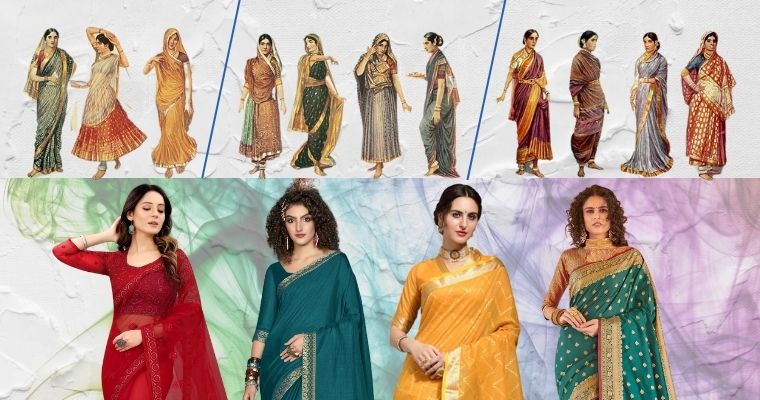Nine Yards of cloth creates magic in every generation of women’s lives, it may be baby boomers or Gen Z. Indian saree, a timeless garment has been every woman’s choice across the globe.
Is the saree the same as it was a thousand years ago – in terms of style and draping?
Indian saree has come a long way from a humble draping to a fashionable garment. The origin of the saree was spotted in the Indus Valley Civilisation, which then burgeoned during 2800 – 1800 BCE around the northwest part of India.
The Journey of Indian Saree
The journey of the Indian saree began with a soft material, “cotton” providing comfortable wear to women of all groups. The word saree developed from the word “Satika” which means women’s attire. Satika is a three-piece cloth comprising ‘antariya’, the lower part; the ‘uttariya’; a veil worn over the shoulder or the head; and the ‘stanapatta’, a chest band. The Sanskrit literature and Buddhist Pali literature incorporated this ensemble during the 6th century. The saree has come under the influence of a plethora of cultures and traditions. And reached a complete form that is loved and accepted by women around the world as comfortable and stylish wear.
Evolution
Saree, what the ladies are wearing today was not the same in ancient days. It has been continuously changing using different fabrics, styling, and dyes to make it the most comfortable and graceful wear for all women.
Every major dynasty starting from the Aryans to the Mauyras, the Guptas, and the Mughals contributed to the evolution of the Indian saree. The saree, as it is today, the most preferable garment for festivals and functions, was developed in the post-Mughal period.
After the Mughal dynasty, Britishers came. And in that period, rich Indian women came up asking the artisans to use fancy stones, mirrors, gold-plated borders, and embroideries to make exclusive sarees for them.
Did the saree remain biased and adapted by one class or strata?
Saree didn’t remain biased as a cloth. Rather, it was adapted by each class, in their own way. Saree remained the most demanded garment, irrespective of the class they belonged to.
During Industrialisation, local traders started importing chemical dyes, techniques of dyeing and printing, which made saree more dazzling and exquisite.
There is a huge transformation in the stitching pattern of the sarees, from baby boomers to generation Z. Addition of new colors and designs to the existing stitching patterns made the saree more appealing to everyone’s eye.
In terms of draping and length of the saree, there is also a tremendous difference between these two generations, Baby Boomers & Gen Z. In India, Baby Boomers used to wear nine-yard sarees only. But, Gen Z has got more options to wear a saree. They can select any length of the saree ranging from 4 yards to 9 yards long. They can drape the saree in as many styles as they can. It may be Belt Style, Dhoti style, Neck Drape style, Mumtaz style, Mermaid style, Pant style, Butterfly style, or Lehenga style.
Though there is a far difference between traditional style and contemporary style, still women give importance to traditional sarees in functions and events as it adds more value to their attire.
Bottom line
Evolution of the Indian saree over time made it the most remarkable attire for women of all generations. Saree, the most loved apparel, is gaining acceptance across the world because of its versatility, dignity, and comfort. It’s the only apparel with which you can add more creativity to your lifestyle. Whether you are a baby boomer or gen Z, drape yourself in different styles with matching accessories and walk with confidence, whatever may be the occasion.
Do you love to dress in a traditional style or contemporary style?


very informative thanks for sharing